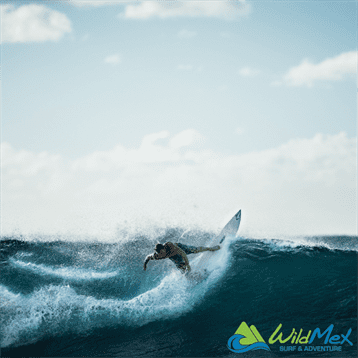Which Surfboard Fin Setup to Choose? Thruster vs Quad Fin

Did you know that your surfboard’s fins play a BIG role in your board’s performance?
Our intermediate surf campers do because that’s just one of the elements we teach within the theory at our surf camp in Punta Mita! Learn more here.
Believe it or not, almost 40% of your board’s performance comes down to your choice of fins, so, we think it’s pretty crucial you know these kinda’ deets that other surf camps don’t take the time to teach you!
This means switching out your fins, or your fin configuration when surfing in Punta Mita and beyond will play a key role in how your board is going to want to be surfed and therefore, how you will perform in the water on any given day. But which surfboard fin setup to choose?
Whether you’re a big wave rider looking to maximize the chances of you making a giant section, or a local surf-enthusiast simply looking for faster ways to go down-the-line, today we are offering you the inside scoop into our surf camp in Punta Mita theory! So, keep reading here to discover more as we explore the difference between these two famous fin setups and learn What and When to ride.
The History of Surfboard fin Setup
The popular quad and thruster share a parallel origin story. Both were developed in the early 80s within Australia and both were a response to the fiasco that almost everyone was having transitioning from single to twin fins! Eeeeep.
What’s the Main Difference of Surfboard Fin Setup?
So, what’s the difference between the Quad (4-fin set-up) and the Thruster (3-fin set-up)?
In short, Quads go faster and Thrusters turn better, but it goes way deeper than that, keep reading here for the details of each for you to consider what’s gonna work best for you…
Why Choose The Quad Fin Set-Up?

Everyone wants that quick but loose feeling while maintaining control when surfing, right? Well, that’s exactly what you get with the quad setup.
Quad surfboard fin setup
This setup brings out the fastest top speeds possible and can be put to play either in big and heavy waves, or small and mushy waves, it all comes down to the fin placement!
Why not try setting up your quad with the rear fins closer to the rail and slightly further up on smaller days for fast maneuvers and flexibility on the tail. And, on bigger days try out the quad with the fins placed back a little and also close to the rail for extra speed and hold on the face of the wave.
The quad will allow you that extra horsepower out the gate compared to the 3fin set-up and once you’re on your feet, don’t be surprised when you experience that instant oomph of down the line speed instead of having to pump your board!
WildMex likes to surf the quad at Burros & Paredon during south swells for better chances of making the faster sections!
Why Choose The Thruster Fin Set-Up?

When will you thrive with the thruster?
On those super rippable days.
Whilst the quad works in both giant or mushy days, the thruster thrives on those high-quality, epic surf days. Think shoulder to slightly overhead, top to bottom, and plenty of room to move around, not too small, not too big, not too fast, and not weak either, just good quality waves that are simply just rippable.
When you have time to perform instead of having to glide and avoid certain sections, the thruster offers optimum performance value, with the fin placement in the back, you’re offered controlled drag that comes in useful when wanting to surf at a higher level on good quality waves.
Thrusters do still work in small waves, and big waves too but that will all come down to your fin of choice, buuuut, that’s for another blog! 😉
WildMex likes to surf the thruster at Burros on North Swells and La Lancha all the time to perform quick, tight turns and pivots!!
The Recap

At our surf camp in Punta Mita, we teach our students about the different surfboard fin setups – their advantages and disadvantages and how finding the right fin setup for your choice of wave and surfing style is crucial to perform better and accelerate your surfing abilities whilst here surfing in Punta Mita and beyond.
The Quad Setup
- Quick
- Fast
- Loose
- Responsive
- Fast-reacting
- Works in a variety of wave types
- Many variations of fin placements to provide whatever type of ride the surfboard was designed for
The Thruster Setup
- Stable
- Predictable
- Radical manoeuvrability
- Controlled drag
- Increased lateral drive
- Performs quick, tight turns and pivots
- Speedy redirection
- Performs at a higher level on good quality waves
- More options available in the marketplace
- More styles and designs on offer too!
What’s Best for You?

With the bulk of surfboards coming in the 5-fin convertible option, the question we often get asked at our surf camp in Punta Mita is:
Which is better, the thruster or the quad?
We have no simple answer to this question, other than – both are superb. It all just depends on what you want and need out of yours! Hence the reason why so many boards come with a 5-fin option, allowing you to experience the variety of both.
In the quest to push the boundaries of the imaginable in waves both big and small, your understanding of the real difference between the thruster and the quad setup is vital, so that you can choose for yourself which is best for YOU.
So, one thing you’ll want to consider when choosing between the fin setup of quad fins vs thruster is which type of waves you’ll be surfing most often; and how exactly you wish your surfing style to be.
We know that thrusters offer more predictability and control while quads are fast-reacting and quick. So, what are you looking for and which is right for you?
Now it’s time to be your own board engineer!
Try both and figure out what works best for you. Changing fins in a board can make the board feel like a completely different board! So, why not give it a go?

In the area and looking at surfing in La Lancha? We offer a variety of boards from Single fin to Thrusters and Quad fin setups from our rad range of 300+ surfboards at our. Check the range and prices here.
Best of luck!
WildMex











